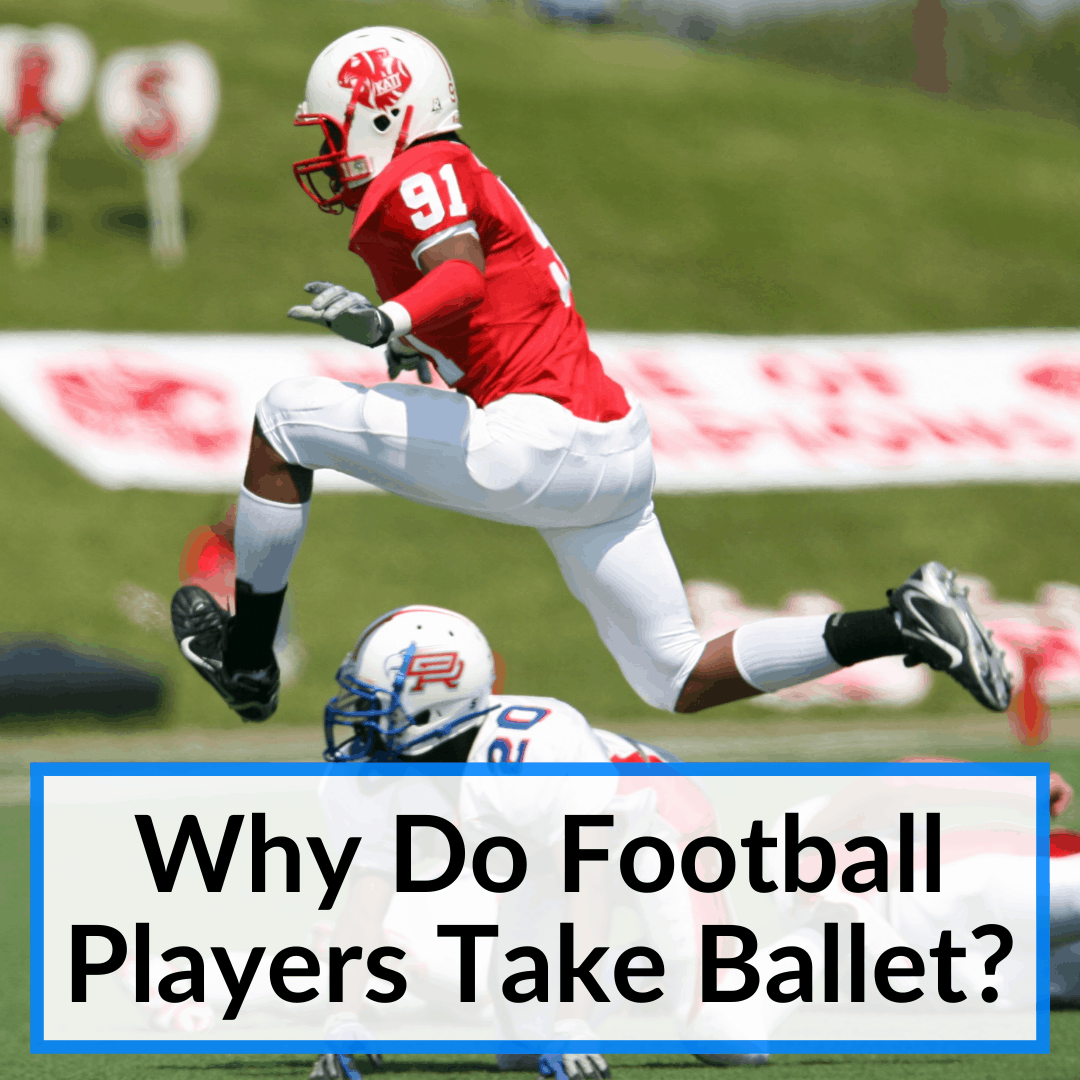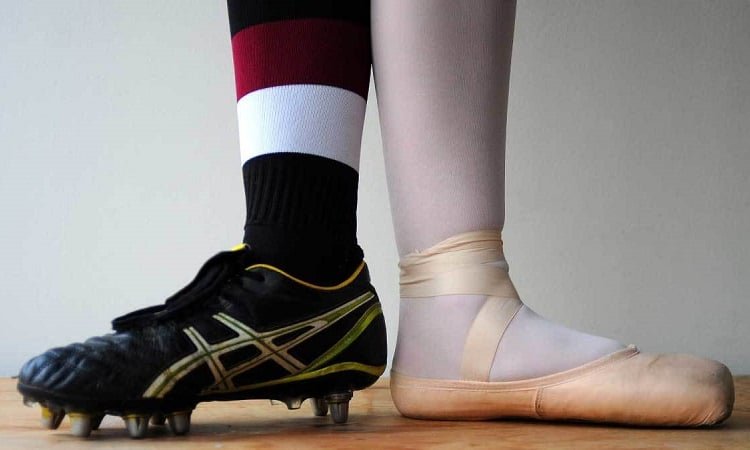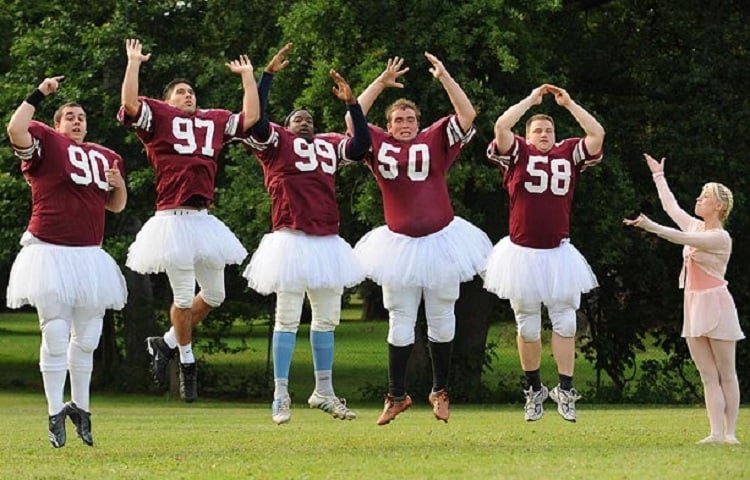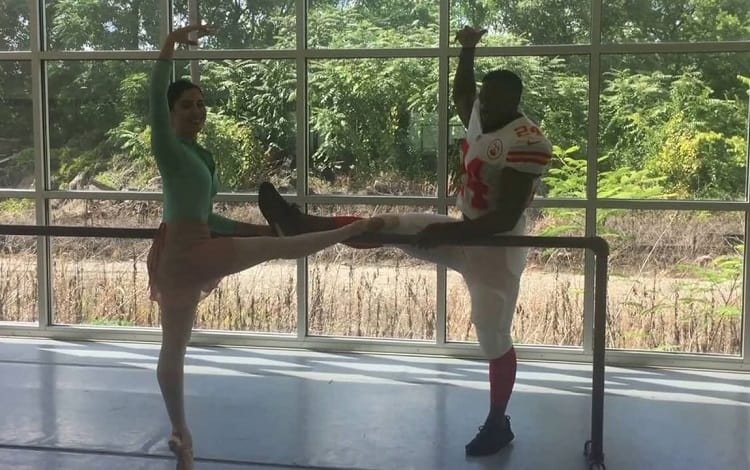 The image of a large football player dancing nimbly on his toes (perhaps even in a tutu) makes people chuckle.
The image of a large football player dancing nimbly on his toes (perhaps even in a tutu) makes people chuckle.
But it is no laughing matter.
Ballet is extremely challenging. Even more so for someone built like the typical football player.
So why do they put themselves through the difficult training, and the potential ridicule?
Because the advantages they gain on the football field are tremendous.
Some are obvious, but others are not. Let’s take a closer look and find out exactly why football players take ballet.
Table of Contents
Why Do Football Players Take Ballet?
Football players take ballet because it is good for them. It’s that simple
Football players have been taking ballet for years, and there’s no chance that this tradition will end anytime soon.
No other physically demanding athletic activity has presented itself as a better option.

We’re going to go into detail on all the reasons that ballet is good for athletes in general, but specifically for gridiron players.
You need to know just how powerful ballet can be to really see its value in sports.
How Ballet Helps Athletes
Ballet improves flexibility, agility, and coordination. It can even improve your mental state by building you up with the confidence necessary to take your game to the next level.
But it’s more than just that. These are all the benefits that you can expect from a good ballet workout as you are an athlete.

Flexibility
Flexibility is more important than you might think. Sure, hundreds of pounds of muscles are great, but if you aren’t flexible, you’re just a brick wall.
Flexibility helps improve your throwing arm, your hip flexors to make longer strides when you run, and it allows your body to move more fluidly while you’re doing every motion in between. Flexibility, along with agility, are the two main reasons football players started getting into ballet in the first place.
Agility
Agility refers to your ability to quickly change positions, direction, and movements. If you can run insanely fast with immense power, but it takes you way too long to slow down, turn around, and run in the opposite direction, you’re not agile.
Agility is when you can redirect force and focus in an instant. As you know, this is extremely helpful during key moments of football.
Agility is the basis for why football players began practicing ballet in the first place. Increased agility helps with ball handling, tackling, blocking, and the way you can play mind games while you’re on the field.
Key Muscle Strength

There are over six-hundred muscles in the human body. Do you think that football works out every single one of them? Well, it doesn’t.
A good gym workout also only targets around two to three-hundred different muscles, depending on how intricate the machinery is.
This means you have untapped muscle potential. You can call the muscles in between the big ones that we all know by name into use as well.
Strengthening these muscles helps make you more flexible and agile. This, in turn, makes it easier to avoid that humongous tackler when you’re carrying the ball. Or to tackle that ball carrier, when you’re the humongous tackler.
Improved Balance
You maintain balance primarily due to a fluid in your ears that helps regulate your relative position. When the fluid is jostled around a lot, you feel dizzy.
Sounds simple, but you can actually train yourself to not get quite as dizzy, and to keep that fluid in place to help improve your balancing capabilities.
This also has to do with muscle control, because the better you can control your muscles without losing your focus, the less you need to rely on that fluid in your ears to help you with balancing.
Realign Your Center Of Gravity
Your center of gravity is extremely important for all things athletic. For men, it sits in the middle of the chest. For women, it sits in the lower abdomen.
This is relative to how our muscles grow. Women have an easier time growing leg and glute muscles, and men have an easier time with upper body muscle groups.
In ballet, you need to have a rock solid center of gravity in order to carry out just about any serious ballet variations for beginners or more advanced ones.
Your center of gravity needs to be aligned to help with balance. It goes without saying that a properly aligned center of gravity can do wonders for your football game.
Coordination
Both physical and hand-eye coordination greatly benefit from proper ballet. But that means doing actual ballet.
If you’re just doing the stretches and trying to make yourself a little more limber, but you aren’t doing the hand motions for the full dance, you’re robbing yourself of hand-eye coordination benefits as well as additional balance.
When football players begin practicing ballet, they’re at an immediate disadvantage. The stereotypical ballerina is a 98-pound slender woman with an elegant step.
Then you have these 250+ pound men entering the scene with an entirely different center of gravity. It is much trickier for someone of that size to coordinate their movements in the way required for ballet.
Even ballet variations for beginners or a are utterly impossible for them. But once they learn how to coordinate their movements, this coordination translates onto the football field. They still can’t do variations or a dance turn in ballet, though.
Famous Football Players Who Practiced Ballet

As we’ve seen, ballet has major benefits to athletes, especially larger men with hundreds of pounds of power built into their bodies. You need to be swift, agile, and nimble on your feet more than anything else.
And these skills carry over to the football field. It should come as no surprise that plenty of professional athletes, including football players, have taken up ballet to gain these advantages over their competition.
Most notably, two hall of fame players practiced ballet for years. They are Herschel Walker and Lynn Swann.
Steve McLendon is also quoted saying that ballet is “Harder than anything else I do” in an interview with CBS.
The list goes on and on. Ballet is hard, but professional football players with their sights set on the hall of fame know that it can give them a big advantage. That makes it worth the effort (and the potential teasing they might have to endure).
Football Players Taking Ballet: Conclusion
To avoid tackles, run with grace, and maintain balance during risky plays, football players need to be on their toes—quite literally.
The skills and athletic dominance you learn through ballet is not only useful on the ballet stage. These same skills provide huge advantages on the football field too.
And the secret is out. Many football players (and other professional athletes) have turned to ballet to increase their balance, agility and coordination. And it has paid off big time.
Even just buying a portable ballet barre for your home can help you gain some of these benefits, so there is no reason not to get started right away.
Ideally though, you would take lessons from a teacher, to ensure you learn the movements the right way. You won’t ever be asked to join a top ballet company, but you will improve your skills on the football field.
Boring